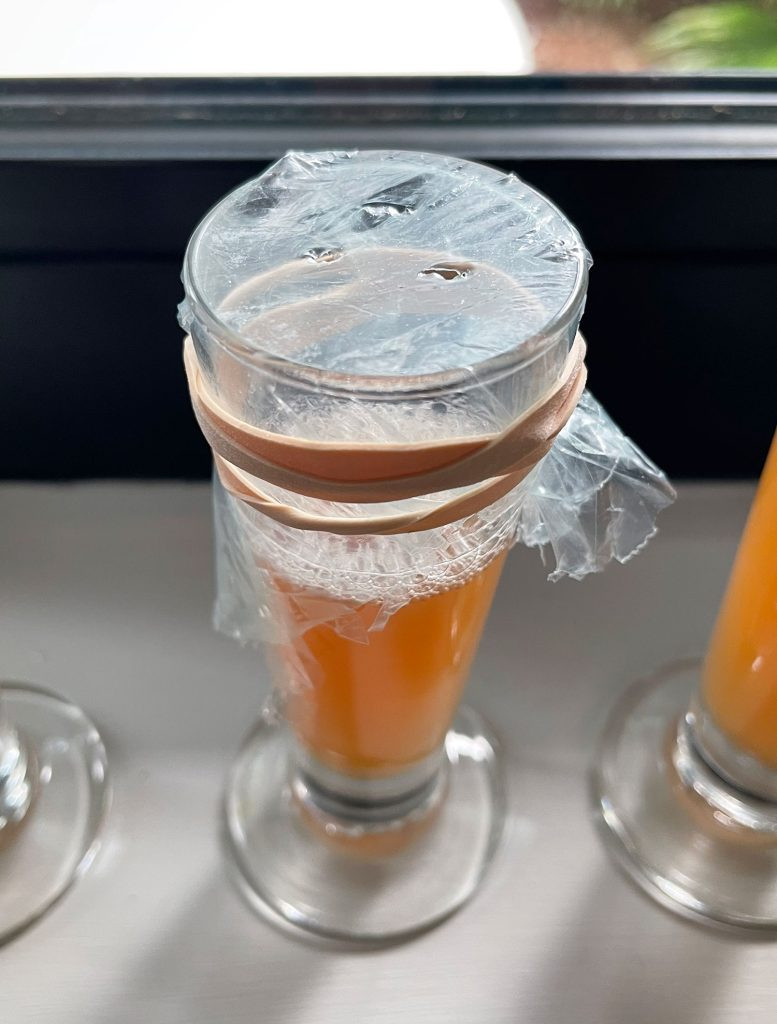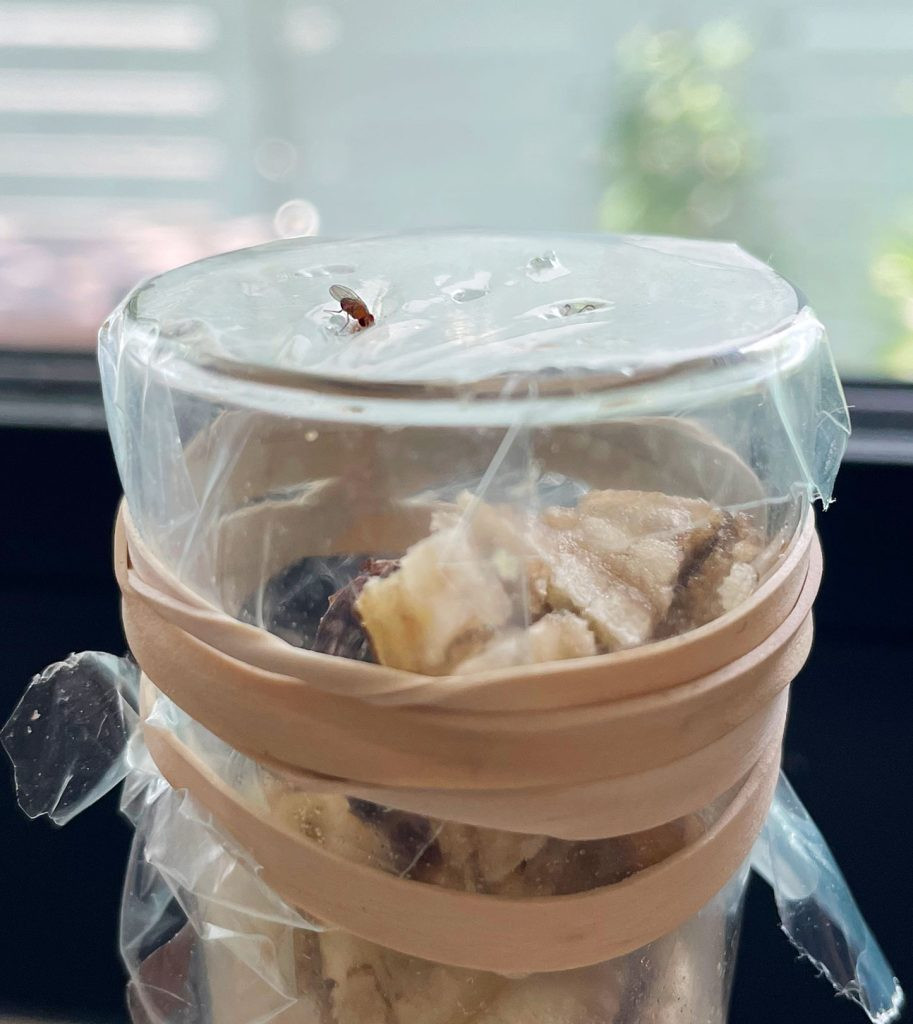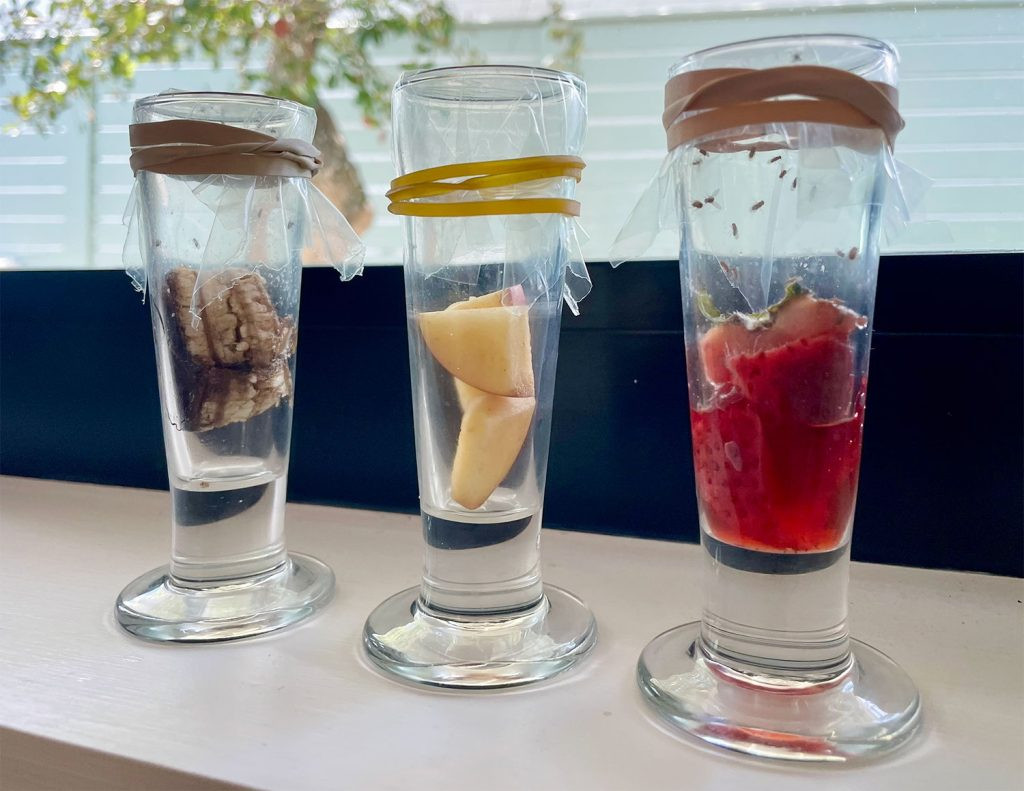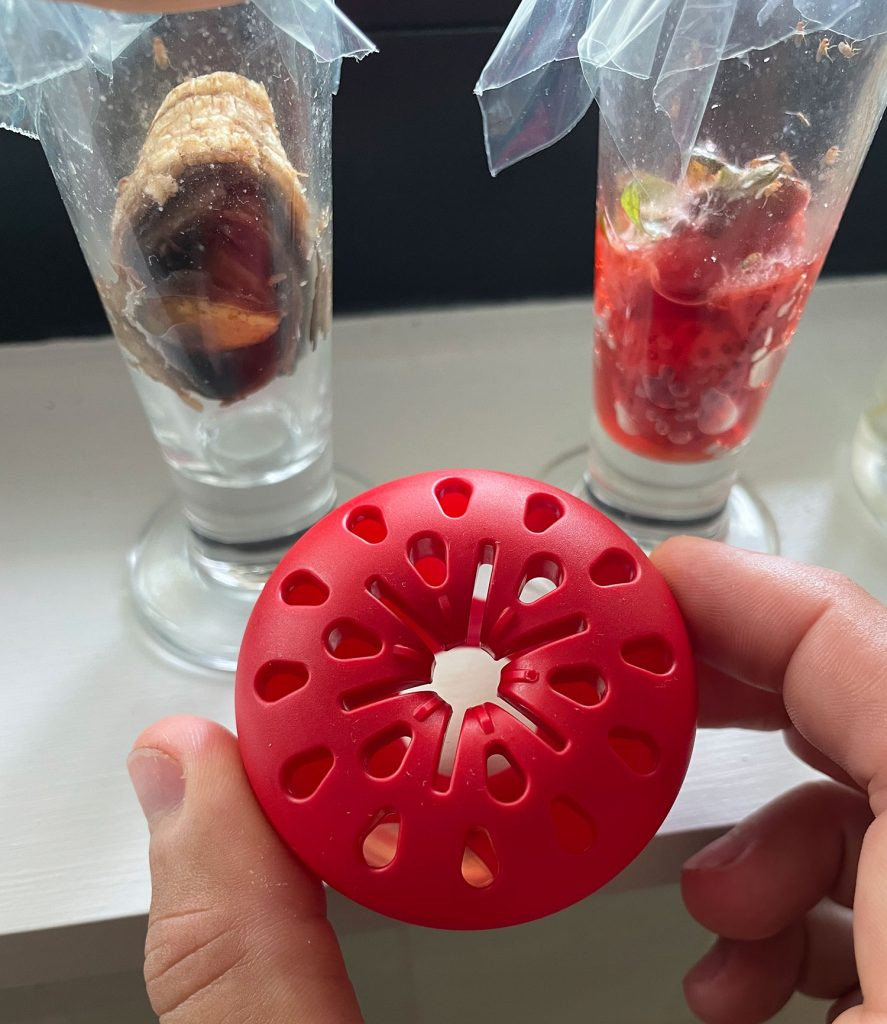Fruit flies, those annoying little pests in your kitchen, are a common problem, but flyermedia.net offers effective solutions. Getting rid of fruit flies doesn’t require expensive products or a lot of effort; you probably already have everything you need at home. Discover effective fruit fly traps and prevention techniques to maintain a pest-free environment, focusing on sanitation and strategic trapping. With the right approach, you can tackle these pests head-on, ensuring a cleaner, more pleasant living space.
1. What Exactly Are Fruit Flies?
Fruit flies are small flying insects that are attracted to ripe fruits and vegetables. These pests are also drawn to sugary and fermented liquids like beer, wine, and juice. You’ll typically see them buzzing around fruit bowls, garbage cans, and kitchen drains. They are about the size of a rice grain and look like tan or brownish houseflies with red eyes. Fruit flies usually appear in the summer or late fall, when many fruits are in season.
It all starts when a few fruit flies hitch a ride on your fruit. Female fruit flies can lay hundreds of eggs in their short lives, with eggs hatching in as little as 12 hours. The pests can reach adulthood in just a few days. It is important to eliminate fruit flies as quickly as possible to prevent a full-blown infestation.
1.1 Fruit Flies vs. Fungus Gnats vs. Drain Flies: What’s the Difference?
It’s easy to mix up fruit flies with other common household pests, especially fungus gnats and drain flies. All of these bugs are small flying insects, but identifying them correctly is important for choosing the right way to eliminate them. You can distinguish between them by where you spot them and which insect they resemble.
- Fruit flies look like small flies. They’re usually found near fruit bowls, trash cans, or other smelly food sources.
- Drain flies look like small fuzzy moths. You’ll typically see them around sinks and drains.
- Fungus gnats look like small mosquitoes. They’re usually found near houseplants, where they breed in damp soil.
If you’re not sure, you can try one of the traps below. If it attracts the pests, you’ve got fruit flies.
2. What Are Some Effective DIY Fruit Fly Traps?
Getting rid of fruit flies doesn’t have to be complicated or expensive. All you need is some household items and patience. Each trap follows the same basic formula: attract the fruit fly and prevent it from escaping. Here are some DIY methods you can try:
- Funnel Trap
- Plastic Wrap Trap
- Dish Soap Trap
- Rotting Fruit Trap
 4 DIY Fruit Fly Traps Tested On Windowsill
4 DIY Fruit Fly Traps Tested On Windowsill
Some traps work faster than others, and it may take several days to completely eliminate the issue.
3. How Do You Make a Funnel Fruit Fly Trap?
This trap attracts fruit flies into a container through a small hole at the bottom of a homemade paper funnel. The flies enter but can’t escape through the small hole.
Supplies needed:
- Small clear jar, cup, or container (preferably with a narrow opening)
- Paper or cardstock
- Tape
- Scissors
- Apple cider vinegar (ACV)
Steps:
- Choose Your Container: Find a small clear container, like an old food jar or plastic soda bottle. A narrow opening works best for this method.
- Add Apple Cider Vinegar: Pour a bit of apple cider vinegar, old beer, or wine into the bottom of the container. The smell attracts fruit flies.
- Make Your Funnel: Wrap a small piece of paper or cardstock into a cone shape with a tiny opening at the tip. Secure it with tape. This opening should be about the size of a rice grain.
- Set Your Funnel: Place the paper cone into the container’s opening. Reshape the funnel so it rests on top without touching the ACV. Make sure it fits snugly to prevent any gaps.
- Optional Outdoor Ending: Carefully take the trap outside, remove the funnel, and let the flies escape.
You can also try this method with a store-bought funnel, but the opening might be too large, letting too many fruit flies escape.
4. How Effective Is the Plastic Wrap Fruit Fly Trap?
This trap attracts fruit flies with the smell of apple cider vinegar. They enter through small holes in the plastic wrap but struggle to find their way out.
Supplies needed:
- Small clear jar, cup, or container
- Rubber band
- Plastic wrap or plastic bag
- Toothpick
- Apple cider vinegar (ACV)
 DIY Fruit Fly Trap With Apple Cider Vinegar And Plastic
DIY Fruit Fly Trap With Apple Cider Vinegar And Plastic
Steps:
- Choose Your Container: Find a small clear jar, cup, or glass container. Using something clear makes it easier to see the flies you’re trapping.
- Add Apple Cider Vinegar: Pour apple cider vinegar into the container. The scent attracts the flies. Old beer or wine also works.
- Cover with Plastic: Wrap the opening tightly with plastic wrap and secure it with a rubber band.
- Poke Small Holes: Use a toothpick to poke a few small holes in the plastic. They should be big enough for a fly to fit through.
- Optional Outdoor Ending: Carefully take the trap outside, remove the plastic wrap, and let the flies fly away.
This technique can also be done by poking a hole in a metal jar lid using a hammer and nail.
5. What Is the Dish Soap Fruit Fly Trap Method?
This trap uses a soapy surface to prevent fruit flies from escaping. Note: you won’t be able to release the flies outside, as they get coated in soap.
Supplies needed:
- Small container, bowl, or dish
- Dish soap
- Apple cider vinegar (ACV)
Steps:
- Put Out Apple Cider Vinegar: Fill the bottom of a small container with apple cider vinegar. This attracts the fruit flies.
- Add Dish Soap & Mix: Squirt several drops of dish soap into the ACV and mix to create a soapy solution. Flies will land on the mixture and find it difficult to fly away.
You can also combine this technique with the plastic wrap or funnel method by adding dish soap to the apple cider vinegar before covering the top. This gives the flies another way to get stuck.
6. How Does the Rotting Fruit Trap Work?
For this trap, you substitute apple cider vinegar with fruit that fruit flies love.
 Fruit Fly Entering Plastic Wrap On DIY Trap
Fruit Fly Entering Plastic Wrap On DIY Trap
Supplies needed:
- Small glass jar, cup, or container
- Plastic wrap or paper funnel
- Small fruit scrap (banana peel or apple slice)
To create this trap, replace apple cider vinegar with a piece of banana peel, apple slice, or peach in either the plastic wrap or funnel trap. You can also add the fruit scrap to your ACV. Replace the fruit scrap every day or two to avoid unwanted smells.
7. Which Fruit Fly Trap Is the Most Effective?
Several DIY traps can be set to see which performs the best. The homemade traps combine different techniques:
- Plastic Wrap Trap with banana peel
- Funnel Trap with ACV + banana peel
- Plastic Wrap Trap with ACV + soap
- Dish Soap Trap with ACV
The lure is the most important factor. Anything with banana peel performs much better than apple cider vinegar. The two plastic wrap traps were nearly identical, but the one with banana peel dramatically outperformed the one with ACV and soap. Real fruit may be more enticing.
Add a fruit scrap to any trap you set up. The plastic wrap trap is easier to make and less prone to disruption. If you knock over a funnel, you might release the flies back into the kitchen.
8. What Is the Best Thing to Attract Fruit Flies?
Fruit scraps are the best bait. Three fruits were tested: a banana peel, apple slices, and a strawberry. Each was put in a plastic wrap trap side-by-side for 24 hours.
 Fruit Fly Traps With Different Rotten Fruit Baits
Fruit Fly Traps With Different Rotten Fruit Baits
The fruit flies ended up being most attracted to the strawberry, even though the banana peel started strong. The longer the strawberry rotted, the more flies it caught. The apple slices didn’t catch any flies.
9. What Are Some Store-Bought Fruit Fly Traps?
If you don’t have the time or materials for DIY solutions, you can buy pre-made traps. These traps have many positive reviews and cost less than $20. They might be worth considering if you want something that catches other types of flying insects or if you want something more discreet than a DIY trap.
During testing, a pack of Terro Traps was tested next to the homemade methods. One was left out for 24 hours next to the banana and strawberry traps to see which performed best.
 Terro Fruit Fly Apple Trap With No Fruit Flies In It
Terro Fruit Fly Apple Trap With No Fruit Flies In It
The homemade strawberry trap did best, followed by the homemade banana peel trap. The store-bought trap caught only one. However, when the DIY traps were discarded and the store-bought trap was left out for another 24 hours, it caught a larger collection of fruit flies.
Store-bought traps are more discreet, especially if you plan to leave them out indefinitely, but homemade traps are the best way to get rid of fruit flies right away.
10. How Can You Prevent Fruit Flies from Infesting Your Home?
While getting rid of fruit flies is simple, preventing them in the first place is even better. Here are some simple ways to prevent fruit flies from taking up residence in your home:
- Clean Kitchen Surfaces: Wipe down kitchen counters, stovetops, tables, and any surfaces that may collect food residue or spilled liquids. Fruit flies are attracted to fruit, sweet juices, and alcohol.
- Take Out Your Trash: Leaving food scraps in your garbage overnight can turn your trash can into a fruit fly breeding ground.
- Dispose of Overripe Fruit: Monitor your fruit bowl for browning or rotting fruit so you can get rid of it before it becomes a problem.
- Wash Your Fruit as Soon as You Get It Home: Eliminate eggs or larvae that might come home from the store by washing produce right away (except for berries, which could rot faster from the moisture).
- Store Produce in the Fridge When Possible: Fruit flies won’t flourish in the cold, so when in doubt, store your fruit and vegetables in the refrigerator.
- Clean Your Sink Drain: Food scraps left in your drain can also attract fruit flies, so make sure you run your garbage disposal and flush the drain regularly.
Don’t panic when you spot fruit flies in your home. Take action quickly to prevent the problem from getting worse. The solutions are easy, effective, and fast-acting.
11. What Role Does Sanitation Play in Preventing Fruit Flies?
Sanitation plays a vital role in preventing fruit fly infestations. Fruit flies are drawn to decaying organic matter, making unsanitary conditions ideal breeding grounds for them. Therefore, maintaining cleanliness in and around your home is essential in preventing fruit fly problems.
- Regular Cleaning: Regularly cleaning countertops, floors, and other surfaces helps remove potential food sources that attract fruit flies.
- Proper Waste Management: Emptying trash cans regularly and ensuring they are properly sealed helps prevent fruit flies from accessing decaying organic matter.
- Food Storage: Storing fruits and vegetables properly, either in airtight containers or in the refrigerator, can prevent fruit flies from accessing them and laying eggs.
According to the University of California, Davis, proper sanitation is one of the most effective strategies for controlling fruit flies in homes and commercial establishments.
12. How Do Fruit Flies Impact the Aviation Industry?
While fruit flies may seem like a purely domestic nuisance, they can also impact the aviation industry in several ways. Although not directly related to aircraft operation, their presence can cause issues in airport facilities, cargo handling, and even agricultural inspections.
- Airport Facilities: Fruit flies can be a nuisance in airport terminals, restaurants, and food storage areas. Their presence can lead to unsanitary conditions and potential health code violations.
- Cargo Handling: Fruit flies can infest shipments of fruits and vegetables, leading to spoilage and potential rejection of cargo. This can disrupt supply chains and cause economic losses.
- Agricultural Inspections: Strict agricultural inspections are in place to prevent the introduction of invasive species, including fruit flies, into new regions. Failure to comply with these regulations can result in fines, delays, and even legal action.
According to the International Air Transport Association (IATA), maintaining high standards of hygiene and sanitation is crucial in preventing the spread of pests, including fruit flies, in the aviation industry.
13. How Do Temperature and Humidity Affect Fruit Fly Infestations?
Temperature and humidity play significant roles in the life cycle and proliferation of fruit flies. Understanding these environmental factors can help in implementing effective control measures.
- Temperature: Fruit flies thrive in warm temperatures, typically between 70°F and 80°F (21°C to 27°C). Their development from egg to adult is accelerated in warmer conditions, leading to faster reproduction rates.
- Humidity: High humidity levels provide the moisture needed for fruit fly larvae to develop and thrive. Moist environments also promote the growth of mold and bacteria, which serve as additional food sources for fruit flies.
According to research from the University of Florida, controlling temperature and humidity levels in indoor environments can help reduce fruit fly populations.
14. How Does Flyermedia.net Provide Information on Pest Control?
Flyermedia.net offers a range of information and resources on pest control, focusing on the aviation industry and related environments. Here’s how flyermedia.net supports efforts in pest management:
- Comprehensive Guides: Offers detailed guides on identifying and managing common pests, including fruit flies, in airport facilities and aircraft.
- Expert Advice: Features insights from pest control professionals, providing practical tips and strategies for effective pest management.
- Product Reviews: Provides reviews and comparisons of pest control products, helping users make informed decisions about which products to use.
- Regulatory Updates: Keeps users informed about the latest regulations and guidelines related to pest control in the aviation industry, ensuring compliance and best practices.
By offering these resources, flyermedia.net aims to support a safe and hygienic environment within the aviation sector.
15. What Are Some Advanced Strategies for Fruit Fly Control?
For persistent fruit fly infestations, more advanced strategies may be necessary. These include:
- Insect Growth Regulators (IGRs): These substances disrupt the development of fruit fly larvae, preventing them from reaching adulthood.
- Professional Pest Control Services: Pest control professionals have the knowledge, experience, and tools to effectively eliminate fruit fly infestations.
- Source Reduction: Identifying and eliminating the sources of fruit fly attraction is crucial. This may involve thoroughly cleaning drains, removing decaying organic matter, and improving ventilation.
According to the Environmental Protection Agency (EPA), integrated pest management (IPM) strategies, which combine multiple control methods, are the most effective for long-term fruit fly control.
16. What Are the Potential Health Risks Associated With Fruit Flies?
While fruit flies are generally considered nuisance pests, they can pose some health risks, particularly in environments where food is prepared or stored.
- Contamination: Fruit flies can carry bacteria and pathogens on their bodies, which can contaminate food and surfaces. This can lead to foodborne illnesses and other health problems.
- Allergies: Some people may be allergic to fruit flies or their droppings, leading to allergic reactions such as skin rashes, sneezing, and asthma.
- Psychological Distress: The presence of fruit flies can be distressing and unpleasant, particularly in food preparation areas.
According to the Centers for Disease Control and Prevention (CDC), maintaining proper hygiene and sanitation is essential in preventing the spread of diseases carried by pests, including fruit flies.
17. How Can Flyermedia.net Help Aviation Professionals Manage Pests?
Flyermedia.net is a valuable resource for aviation professionals seeking information and solutions for pest management. The website offers:
- Industry News and Updates: Keeps aviation professionals informed about the latest developments in pest control, including new technologies, regulations, and best practices.
- Training Materials: Provides access to training materials and resources on pest identification, control, and prevention.
- Networking Opportunities: Connects aviation professionals with pest control experts and suppliers, facilitating collaboration and knowledge sharing.
- Case Studies: Shares real-world examples of successful pest management programs in the aviation industry, providing insights and lessons learned.
By offering these resources, flyermedia.net helps aviation professionals maintain safe and hygienic environments, protecting passengers, employees, and cargo from the risks associated with pests.
18. What Are the Regulatory Requirements for Pest Control in Aviation?
The aviation industry is subject to strict regulatory requirements for pest control to prevent the spread of diseases and invasive species. These requirements are enforced by various government agencies, including:
- The World Health Organization (WHO): Provides guidelines for aircraft disinsection and other measures to prevent the international spread of diseases.
- The International Civil Aviation Organization (ICAO): Sets standards and recommendations for aircraft hygiene and sanitation.
- National Aviation Authorities: Enforce national regulations on pest control in airports and aircraft.
Compliance with these regulatory requirements is essential for maintaining public health and preventing disruptions to air travel.
19. How Can You Create a Sustainable Fruit Fly Control Program?
Creating a sustainable fruit fly control program involves implementing strategies that are effective, environmentally friendly, and economically viable. Key components of a sustainable program include:
- Integrated Pest Management (IPM): Combining multiple control methods, such as sanitation, trapping, and biological control, to minimize reliance on chemical pesticides.
- Preventive Measures: Focusing on preventing fruit fly infestations through good sanitation practices, proper food storage, and regular monitoring.
- Education and Training: Educating employees and residents about fruit fly prevention and control, empowering them to take proactive measures.
- Monitoring and Evaluation: Regularly monitoring fruit fly populations and evaluating the effectiveness of control measures, adjusting strategies as needed.
By implementing a sustainable fruit fly control program, you can minimize the risks associated with pesticide use, protect the environment, and ensure long-term pest management success.
20. How to Handle Fruit Flies in Commercial Establishments
Fruit flies in commercial establishments, such as restaurants, grocery stores, and food processing plants, can be a major problem. These pests can contaminate food, damage reputation, and lead to regulatory violations.
Here are some key strategies for effectively managing fruit flies in commercial settings:
-
Implement Strict Sanitation Practices: Regular and thorough cleaning is essential to remove food debris and potential breeding sites. Pay special attention to drains, spills, and hard-to-reach areas.
-
Use Commercial-Grade Traps: Invest in high-quality fruit fly traps designed for commercial use. These traps often use stronger attractants and more effective trapping mechanisms.
-
Partner with a Pest Control Professional: Engage a licensed pest control company with experience in commercial pest management. Professionals can conduct thorough inspections, develop customized treatment plans, and provide ongoing support.
-
Train Staff on Prevention: Educate employees on the importance of sanitation, proper food handling, and early detection of fruit flies. Regular training can help prevent infestations and ensure quick response when problems arise.
-
Regular Monitoring and Maintenance: Conduct regular inspections to identify and address any potential issues before they escalate. Schedule routine maintenance of drains, equipment, and structural elements to eliminate breeding sites.
By implementing these strategies, commercial establishments can effectively manage fruit fly infestations and maintain a clean, safe, and compliant environment.
Fruit flies are a common nuisance, but by understanding their habits and implementing effective control strategies, you can eliminate them from your home or business. Regular cleaning, proper waste management, and strategic trapping are essential for preventing infestations.
Are you ready to tackle your fruit fly problem? Flyermedia.net offers comprehensive guides, expert advice, and product reviews to help you choose the best strategies for your needs. Visit flyermedia.net today to discover more tips and solutions for pest control in aviation and beyond. Don’t let fruit flies take over your space; take action now and enjoy a pest-free environment.
FAQ: Fruit Flies
-
What attracts fruit flies to my home? Fruit flies are attracted to ripe, rotting, or fermented fruits and vegetables, as well as sugary spills and liquids.
-
Are fruit flies dangerous? Fruit flies are generally considered nuisance pests and are not known to transmit diseases. However, they can contaminate food and spread bacteria.
-
How quickly do fruit flies reproduce? Fruit flies can reproduce very quickly, with females laying up to 500 eggs at a time. The entire life cycle, from egg to adult, can be completed in as little as 8-10 days.
-
Can fruit flies bite humans? No, fruit flies do not bite humans. They lack the mouthparts necessary for biting.
-
How do I get rid of fruit flies in my kitchen? You can get rid of fruit flies in your kitchen by eliminating their food sources, setting up traps, and maintaining good sanitation practices.
-
Do fruit flies live in drains? Yes, fruit flies can breed in drains where organic matter accumulates. Cleaning drains regularly can help prevent infestations.
-
What is the best bait for a fruit fly trap? Apple cider vinegar, ripe fruit, and a mixture of sugar and vinegar are all effective baits for fruit fly traps.
-
Can I prevent fruit flies? Yes, you can prevent fruit flies by keeping your kitchen clean, storing fruits and vegetables properly, and disposing of overripe produce promptly.
-
Are store-bought fruit fly traps effective? Yes, store-bought fruit fly traps can be effective, especially when used in combination with other control methods.
-
How long do fruit flies live? Adult fruit flies typically live for about 40-50 days.
By visiting flyermedia.net, you can find more detailed information on each of these topics and discover additional resources for managing and preventing fruit fly infestations. With the right knowledge and strategies, you can keep your home or business free from these annoying pests.
Address: 600 S Clyde Morris Blvd, Daytona Beach, FL 32114, United States.
Phone: +1 (386) 226-6000.
Website: flyermedia.net.